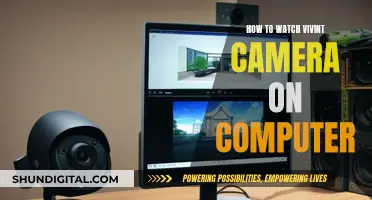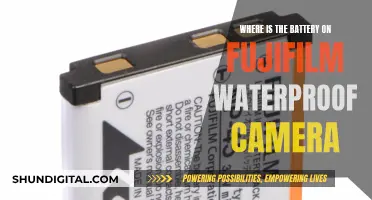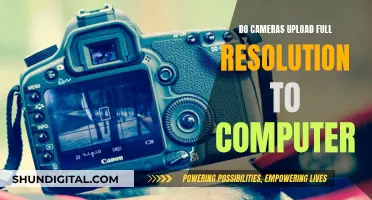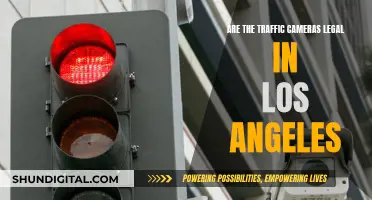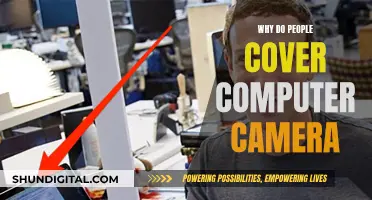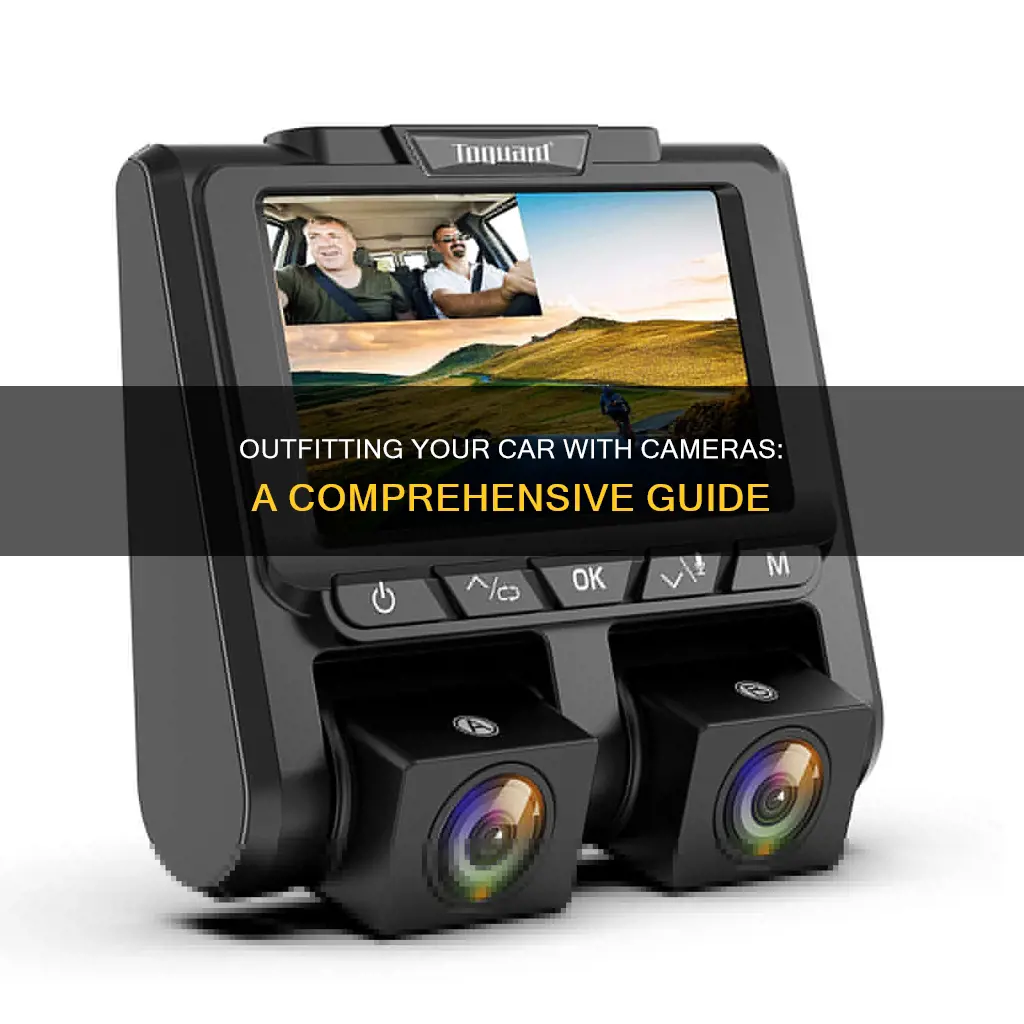
Outfitting your car with cameras can be a great way to monitor your vehicle's surroundings and ensure safety. However, it's important to consider the placement, type of camera, and any legal implications. The first step is to choose small, portable cameras that can be easily hidden and powered by batteries to avoid the need for plugs. You should also decide on the feed options, whether you prefer a live feed or storing footage on an SD card. Next, you'll need to get creative with hiding spots. Common places include vents, the back window, or even carving out a part of the back seat. It's crucial to ensure the camera stays put while driving and to regularly check the footage and battery life. Additionally, be mindful of privacy laws and respect others' privacy when recording outside your vehicle.
What You'll Learn

Buy a portable, small camera
When looking to buy a small, portable camera to outfit your car, there are a few key considerations to keep in mind. Firstly, you'll want to ensure the camera is compact and discreet, especially if you're planning to use it in a rental car or want to avoid obstructing your view. Additionally, look for features such as high-resolution video capture, night vision, motion detection, and loop recording.
- Mini Spy Camera Hidden Full HD 1080P: This tiny camera offers 1080p resolution and features motion detection and night vision. It's portable and covert, making it ideal for discreet recording.
- WiFi Mini Camera: This hidden spy camera provides 4K HD resolution and comes with free cloud storage and an SD card. It boasts an impressive 150-day standby time and includes AI motion detection and night vision.
- Dash Cam 3 Channel 1080P: This compact dash cam captures footage in 1080p resolution and includes a 32GB card. It has a G-sensor, 24-hour parking mode, and loop recording functionality.
- Mini Spy Hidden Camera 4K: This wireless WiFi camera is small and portable, offering 4K resolution and 100 days of standby battery life. It features AI motion detection and night vision, making it a versatile option for car recording.
- SIRGAWAIN Mini Body Camera Pen 1080p: If you're looking for an ultra-discreet option, this mini body camera pen captures 1080p video and comes with a 64GB MicroSD card. It's a compact and portable solution for those who want an inconspicuous recording device.
- Viofo A119 V3 2K Dash Cam: While slightly larger than the other options, this dash cam captures crisp 2K resolution footage with ultra-clear night vision. It has a wide 140-degree field of view and includes buffered parking mode and motion detection.
- Garmin Dash Cam Mini 2: This tiny dash cam from Garmin measures just 1080p and offers a 140-degree field of view. It's a compact and discreet option for those seeking a simple and portable solution.
Charging Your Camera in Europe: What You Need to Know
You may want to see also

Consider feed options
When considering how to outfit your car with cameras, it is important to think about how you want to access the camera feed. Different cameras are designed to capture and deliver the feed in different ways.
If you want to access a live feed of your car, you will need a camera with a WiFi connection. However, WiFi may not always be available, and you may need to rely on mobile hotspots for internet access.
Most cameras will use an SD card to save video footage, which can be viewed later by connecting to the camera or removing the SD card and inserting it into another device. If you opt for a camera that does not provide a live feed, be sure to purchase one capable of storing video on an SD card.
Additionally, consider whether you want to be able to view the camera feed remotely or only when you have physical access to the camera or SD card. This will impact the type of camera and feed options you choose.
Some cameras may also offer apps that allow you to monitor the camera feed and control various settings remotely. These apps can also provide notifications and updates to ensure your camera is functioning properly.
When deciding on the camera setup for your car, carefully consider your specific needs and requirements. Choose a camera that offers the feed and access options that align with your intended use.
The Ultimate Camera Companion: DE-A93 Battery Charger
You may want to see also

Disguise the camera
Disguising a camera is a great way to keep your car safe without drawing attention to it. Here are some tips to disguise a camera in your car:
Choose a Small Camera
The first step to disguising a camera is to select a small, compact device. Smaller cameras are easier to hide and less likely to be noticed. They can also be tucked away in tight spaces and are often portable and battery-operated, making them convenient for car installations.
One effective way to disguise a camera is to make it look like an everyday item. You can find cameras disguised as power banks, USB drives, alarm clocks, car remotes, and even pens. These items can be left out in the open without raising suspicion, and some, like the pen, are even functional.
Hide the Camera in Plain Sight
Consider hiding your camera in plain sight by disguising it as something commonly found in a car. For example, you could place it inside an empty cleaning bottle or tissue box. You could also hide it under items typically found in a car, such as sweaters, jackets, or stuffed animals.
Place the Camera in a Vent
Vents are an excellent location to hide a camera as they are often overlooked by passengers. Just make sure the camera is small enough to fit inside without obstructing the view or significantly impacting airflow.
Carve Out a Space in the Backseat
If you're willing to make some cosmetic changes to your car, you could try carving out a small space in the backseat to hide the camera. This provides a great view and keeps the camera well-hidden. Just be sure to test the camera angle and consider using a see-through cloth to disguise the lens.
Other Creative Hiding Places
There are plenty of other creative places to hide a camera in your car. You could attach it to the rear-view mirror, clip it to the sun visor, or hang it from the rear-view mirror as a pair of fuzzy dice or a reusable trash bag. Just be mindful of the camera angle and ensure it won't be easily discovered or tampered with.
Is My Camera Hacked? Signs to Watch Out For
You may want to see also

Place the camera in a vent
Placing a camera in a vent is a great way to hide it in plain sight. Vents are in every car, and most people don't bother to inspect them when entering a vehicle, so they are a great place to conceal a camera. However, there are a few things to keep in mind when choosing this option.
First, ensure that the camera is small enough to fit inside the vent. The camera should be portable and battery-operated so that you don't have to worry about keeping it plugged in, which could give away its location. You will need to detach the vent cover and place the camera inside, being mindful not to obstruct the camera view with the vent cover.
Second, consider the impact on airflow and air quality in your car. The camera will be out of sight, but the vent cover may obstruct the camera view, so be sure to check the feed to ensure the blockage is not too much. Also, be aware that the person in the car may close the vent, which could completely block the camera's view. So, make sure to monitor that vent carefully to ensure nothing obstructs the view.
Third, consider the temperature of the air moving through the vents. Depending on the car's temperature settings, the camera may be exposed to very hot or cold air. While this is unlikely to affect the camera, it is important to read up on the temperatures that the camera can safely withstand.
Overall, placing a camera in a vent is a safe and discreet option for surveillance in your car. Just be sure to choose a small, portable, battery-operated camera, and regularly check that the vent is not obstructing the camera's view.
Transmitting Camera Footage to Computers: Easy, Quick Methods
You may want to see also

Carve out a part of the backseat
Carving out a part of the backseat is a clever way to hide a camera in your car, especially if you want to keep a close eye on the vehicle's occupants or ensure its safety. While this method may not be ideal for brand-new cars, it can be quite effective for older vehicles. Here's a step-by-step guide to help you outfit your car with a camera by carving out a portion of the backseat:
Step 1: Choose the Right Camera
Select a small, portable camera that runs on battery power. This will give you more flexibility with placement and make it less likely to be spotted. Additionally, a portable camera eliminates the need for plugging it into a power source, which can give away its location.
Step 2: Plan the Installation
Before making any cuts, carefully plan the installation. Determine the best location for the camera within the backseat, ensuring it has a clear view of the car's interior. Mark the spot where you will be cutting, keeping in mind that you want to minimize the number of cutting locations.
Step 3: Cut a Hole in the Backseat
Using appropriate tools, carefully cut a hole in the backseat according to the markings from your planning step. Make sure the hole is large enough to accommodate the camera and any necessary adjustments. Be cautious and take your time during this step to avoid damaging any essential structures or mechanisms within the seat.
Step 4: Place the Camera
Insert the camera into the hole you've created. If the camera is still visible or you want to enhance its concealment, consider covering it with a piece of see-through cloth that matches the color of the seat. This will help disguise the camera lens while still allowing it to capture footage.
Step 5: Test and Adjust
Once the camera is in place, thoroughly test its functionality. Check the camera feed to ensure it provides a clear and unobstructed view. Make any necessary adjustments to the camera angle or position to optimize the footage. Additionally, test the camera while driving to ensure it remains stable and doesn't move around.
Step 6: Regular Maintenance
Even after a successful installation, remember to regularly check on the camera. Over time, adhesives or mounting methods may weaken, causing the camera to shift or become dislodged. Additionally, keep an eye on the camera's battery life, as hidden cameras often don't provide low-battery notifications. Regular maintenance will help ensure that your camera remains operational and well-hidden.
The Evolution of Wyze Cameras: Battery or Plug-In?
You may want to see also


